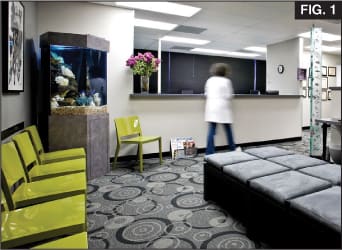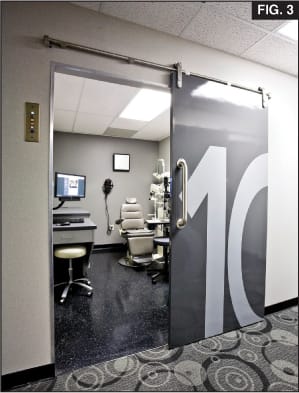Stopping Bottlenecks in Your Office
Proven advice on how to streamline patient flow
By Sarah E. Cwiak, MBA, COE
There are few things in life I dread more than those ropes they put up to corral people waiting in line at airport security, amusement parks, the movie theater and, worst of all, the DMV. I understand that the ROI on building enough Space Mountains that no one ever has to wait in line at Disney World is unrealistic, but when I see those mazes of retractable seat belts I want to scream.
Jerry Seinfeld does a bit where he talks about waiting rooms in doctors' offices with the same dismay. In his routine, he says, “There's no chance of not waiting, because if they call it the waiting room, they're going to use it.” After I heard this pointed critique of our profession, I set out to do away with our waiting room altogether. Could it be done in a large group practice with many doctors and a two-OR surgical center like ours? What I found was we had bottlenecks popping up frequently in certain areas of the office.
Getting to the Root of the Problem
We started by evaluating our patient wait times and looking for variables that consistently cause delay. Our long waits and office bottlenecks occurred at 10 am and 2 pm. By contrast, the last appointment before lunch and the last one on Friday afternoon experienced the shortest wait time. Staffing and scheduling templates are consistent, so we knew one thing: if our staff wanted to handle the volume, they could!
Next we looked at each stage of the patient visit, starting with check in. We have several offices, each with multiple doctors. The schedules were organized to bring in three patients per doctor every 20 minutes. If we have three doctors in one location, we start our day with nine patients trying to check in at exactly the same time, yet we only have three check-in desks. That is not exactly setting up our front office staff for success, so we looked at our schedule templates more closely. If you decide to re-evaluate your schedule, make sure you have at least one clinical person involved. They will offer you an invaluable perspective. We staggered doctor start times and started giving some patients non-traditional appointments like 9:20 or 9:40.
Next, we looked at the time our patients spend with their doctor. We found that physicians need to see a patient just once per visit — provided all the diagnostic tests have been finished prior to that encounter. The doctor sees the patient and the exam is finished. No more “Jack in the box” doctors popping in and out of rooms! This takes a few things to accomplish: proper tech training, consistent doctors and periodic retraining.

Tech training also means empowering your techs! We asked our doctors to “teach, not tell.” If a patient doesn't have all the necessary testing finished before the doctor walks in the door, we ask our doctors to go back to the tech who did the work-up and explain what symptoms or triggers made them need additional diagnostic data on the patient. Once our doctors started teaching our techs, a mutual respect bloomed. Also, all the doctors in the practice need to agree on the symptoms and other patient factors that indicate the need for each test. Consistency is key to efficiency.
Our retraining process consists of techs periodically sharing what the doctors teach them. We encourage conversations that start with, “The doctor told me that if a patient has corneal scarring, they will not be a multifocal lens candidate, because…” The technician is expected to articulate the reasoning for the protocol to the best of his or her abilities. That prevents delays and can also help with patient education; a well-educated tech can field patient questions during the test, lessening the time commitments of the physicians. We also ask manufacturer sales reps to host periodic “lunch-and-learn” meetings to keep our techs up to date in their skills and always in the mindset to ask questions.
Doctors being consistent in their clinical routine helps us more accurately gauge how long appointments will take for scheduling, gives techs stability in decision making and keeps things moving. I tell our doctors that if we have a road map, we will stay on course and not get lost! Keeping our doctors consistent is very difficult but worth the effort.
One habit that needed curtailing was the doctors' common practice of arranging follow-up visits directly with patients. At the end of an exam, our doctors were often telling patients, “I can see you next Tuesday at 9 am.” They would sometimes quadruple-book a time slot for no urgent reason. I was shocked to find that the worst “exception makers” in the office were doctors. They were unaware of the back-ups they were causing themselves. We asked them to start saying, “Let's have the ladies out front find you a convenient time. I want to make sure you don't get ‘crammed’ into the schedule, so that you and I have enough time to talk.” This has helped with what we call “per the doctor” scheduling exceptions.
Optical was another area that often needed waiting line ropes! We realized that we could predict pretty easily what types of appointment were likely to end in the optical gallery, so we again looked at how we schedule patients. We trained a few front-office workers in frame style considerations so that they can at least start the process. Although we do everything we can to avoid back-ups, when they happen we tell patients that we are running behind in optical and they are welcome to wait, or if they don't have the time right now we can schedule them an appointment. If they chose to come back, we give them a discount card for the inconvenience. That's better customer service than forcing people to wait, and it prevents a delay in patient flow for others at the practice. This is also good because management tracks how many discount cards we give out and how many are returned.
The last thing we changed was our procedure to confirm appointments. This used to be considered an “anybody can do it in their spare time” sort of task. At one point, we had an automated system making calls for us. Now, a specific person confirms each appointment and is also responsible for “hawking” the schedule to identify problems and possible back-ups. She was given override responsibility on the schedule, so she is empowered to reroute traffic jams before they happen. We give her reports on patient wait times — and give her kudos for smooth-running days. Our older patients like that they are talking to a person instead of a machine, and our doctors like that fewer traffic jams happen.
After a few weeks, she started to have a feel for the schedule and which types of patients would or wouldn't mind small adjustments. She now comes to realizations such as, “surgery patients usually take the entire day off work, so they don't mind if we move them an hour in either direction.” These sort of insights were impossible when we used the automated calling system, and not much easier to come by when confirmations were treated as an afterthought and lacked a dedicated staff member with responsibility.
In the end, we cut 18 minutes off our average patient visit — a savings that any of us would certainly welcome the next time we are in line at the DMV. With a few simple adjustments, you too can help your patients avoid tedious wait times and also eliminate wasteful delays at your own busy medical office. OM
| Sarah E. Cwiak, MBA, COE, is practice administrator for Dr. Brad Black's Eye Associates and Vision Surgical Center in Jeffersonville, IN. |
Office Design That Combines Aesthetics and EfficiencyBy Samuel Masket, MD, and Barbara MasketGiven our expectations for the delivery of high-volume health care in the future, and the need for economies of scale, we recently decided to expand our practice by adding an additional physician and acquiring another practice. As a result,we needed to enlarge our existing office space, and by happenstance, our five-year lease was coming to an end. Imagine our horror when the landlord imposed a 21% increase in the base rent, despite the increase in square footage! This stimulated a need to consider efficient use of space. Most fortunately, one of us (Barbara), has a masters in architecture. One of our design considerations was to avoid the use of the traditional swing door into each of the 12 examination rooms. This small move eliminated wasted space and has ultimately saved approximately $500/month in rent. That is roughly equivalent to one cataract surgery per month. When the practice was started in LA, more than 30 years ago, one cataract procedure alone covered the rent. Today, it takes more than 30 cases to do so. Therefore, every opportunity to trim an expense is mandatory. When preparing for our expansion, we took the opportunity to use space more efficiently, and also took into consideration aesthetics and humor to create a well-organized, creative and appealing exam room design that is both functional and durable. In the reception area, we omitted the glass wall that usually separates patients and staff, as a way of presenting the openness and honesty of the physicians in this office (Figure 1). A silent TV is set to shows such as cooking and travel — healthy and optimistic activities. And to help patients make productive use of their time, there are a variety of computers available for those who want to check email or watch educational programs created by our office (Figure 2). 
There are critical problems when designing a medical office — the exorbitant cost per square foot in Los Angeles being the most obvious. To create a statement as well as a utilitarian response to the space issue, we used “barn doors” at each exam room. Each door is numbered and covered in a glossy gray vinyl with five-foot tall numbers, in a lighter shade of gray, falling slightly off the edge, creating a bit of whimsy (Figure 3). As the patients walk through the office, there is something to look at, something to think about, something to figure out. 
The next test was to ask the doctors to walk through this new space as a patient and judge it on the comfort, ease of use and clarity of space. How many physicians have undertaken that experience themselves? It is well worth it to see your practice through the eyes of your patients. The ultimate test of our success is patient commentary. The positive comments we have received since our redesign have been an inspiration to the staff and an unexpected plus for the project. Pride of space has increased pride in care. Hopefully, our patients will feel that the doctors care as much about them as they did about their environment when creating such a space, and that we have created a balance between science and design. Dr. Masket practices at Advanced Vision Care in Beverly Hills, Los Angeles. His wife Barbara is office administrator for the practice. |









